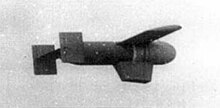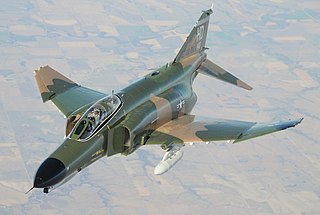
The McDonnell Douglas F-4 Phantom II is an American tandem two-seat, twin-engine, all-weather, long-range supersonic jet interceptor and fighter-bomber that was developed by McDonnell Aircraft for the United States Navy. Proving highly adaptable, it entered service with the Navy in 1961 before it was adopted by the United States Marine Corps and the United States Air Force, and by the mid-1960s it had become a major part of their air arms. Phantom production ran from 1958 to 1981 with a total of 5,195 aircraft built, making it the most produced American supersonic military aircraft in history, and cementing its position as a signature combat aircraft of the Cold War.

A surface-to-air missile (SAM), also known as a ground-to-air missile (GTAM) or surface-to-air guided weapon (SAGW), is a missile designed to be launched from the ground or the sea to destroy aircraft or other missiles. It is one type of anti-aircraft system; in modern armed forces, missiles have replaced most other forms of dedicated anti-aircraft weapons, with anti-aircraft guns pushed into specialized roles.

A glide bomb or stand-off bomb is a standoff weapon with flight control surfaces to give it a flatter, gliding flight path than that of a conventional bomb without such surfaces. This allows it to be released at a distance from the target rather than right over it, allowing a successful attack without exposing the launching aircraft to anti-aircraft defenses near the target. Glide bombs can accurately deliver warheads in a manner comparable to cruise missiles at a fraction of the cost—sometimes by installing flight control kits on simple unguided bombs—and they are very difficult for surface-to-air missiles to intercept due to their tiny radar signatures and short flight times. The only effective countermeasure in most cases is to shoot down enemy aircraft before they approach within launching range, making glide bombs very potent weapons where wartime exigencies prevent this.

Fritz X was a German guided anti-ship glide bomb used during World War II. Fritz X was the world's first precision guided weapon deployed in combat and the first to sink a ship in combat. Fritz X was a nickname used both by Allied and Luftwaffe personnel. Alternative names include Ruhrstahl SD 1400 X, Kramer X-1, PC 1400X or FX 1400.

The Henschel Hs 293 was a World War II German radio-guided glide bomb. It is the first operational anti-shipping missile, first used unsuccessfully on 25 August 1943 and then with increasing success over the next year, damaging or sinking at least 25 ships. Allied efforts to jam the radio control link were increasingly successful despite German efforts to counter them. The weapon remained in use through 1944 when it was also used as an air-to-ground weapon to attack bridges to prevent the Allied breakout after D-Day, but proved almost useless in this role.
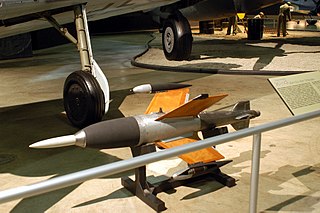
The Ruhrstahl Ru 344 X-4 or Ruhrstahl-Kramer RK 344 was a wire-guided air-to-air missile designed by Germany during World War II. The X-4 did not see operational service and thus was not proven in combat but inspired considerable post-war work around the world, and was the basis for the development of several ground-launched anti-tank missiles.

An air-to-air missile (AAM) is a missile fired from an aircraft for the purpose of destroying another aircraft. AAMs are typically powered by one or more rocket motors, usually solid fueled but sometimes liquid fueled. Ramjet engines, as used on the Meteor, are emerging as propulsion that will enable future medium- to long-range missiles to maintain higher average speed across their engagement envelope.

The Douglas A-4 Skyhawk is a single-seat subsonic carrier-capable light attack aircraft designed and produced by the American aerospace manufacturer Douglas Aircraft Company, and later, McDonnell Douglas. It was originally designated A4D under the United States Navy's pre-1962 designation system.

The Tupolev Tu-4 is a piston-engined Soviet strategic bomber that served the Soviet Air Force from the late 1940s to mid-1960s. The aircraft was a copy of the American Boeing B-29 Superfortress, having been reverse-engineered from seized aircraft that had made emergency landings in the USSR.

The ASM-N-2 Bat was a United States Navy World War II radar-guided glide bomb which was used in combat beginning in April 1945. It was developed and overseen by a unit within the National Bureau of Standards with assistance from the Navy's Bureau of Ordnance, the Massachusetts Institute of Technology, and Bell Telephone Laboratories. It is considered to be the first fully automated guided missile used in combat.

A guided bomb is a precision-guided munition designed to achieve a smaller circular error probable (CEP).
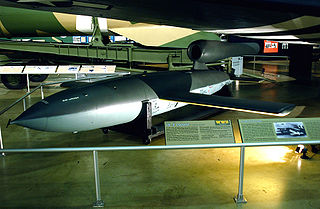
The Republic-Ford JB-2, also known as the Thunderbug, KGW and LTV-N-2 Loon, was an American copy of the German V-1 flying bomb. Developed in 1944, and planned to be used in the Allied invasion of Japan, the JB-2 was never used in combat. It was the most successful of the United States Army Air Forces Jet Bomb (JB) projects during World War II. Postwar, the JB-2 played a significant role in the development of more advanced surface-to-surface tactical missile systems such as the MGM-1 Matador and later MGM-13 Mace.

The VB-6 Felix was a precision-guided munition developed by the United States during World War II. It used an infrared seeker to attack targets like blast furnaces or the metal roofs of large factories. The war ended before it could be used operationally.

The LBD-1 Gargoyle was an American air-to-surface missile developed during World War II by McDonnell Aircraft for the United States Navy. One of the precursors of modern anti-ship missiles, it was extensively used as a test vehicle during the late 1940s.

The 53rd Weapons Evaluation Group is a United States Air Force unit that reports to the 53rd Wing. It is stationed at Tyndall Air Force Base, Florida. The unit is part of Air Combat Command.

A precision-guided munition (PGM), also called a smart weapon, smart munition, or smart bomb, is a guided munition intended to hit a specific target, to minimize collateral damage and increase lethality against intended targets. During the Persian Gulf War guided munitions accounted for only 9% of weapons fired, but accounted for 75% of all successful hits. Despite guided weapons generally being used on more difficult targets, they were still 35 times more likely to destroy their targets per weapon dropped.

The JB-4, also known as MX-607, was an early American air-to-surface missile developed by the United States Army Air Forces during World War II. Using television/radio-command guidance, the JB-4 reached the flight-testing stage before being cancelled at the end of the war.
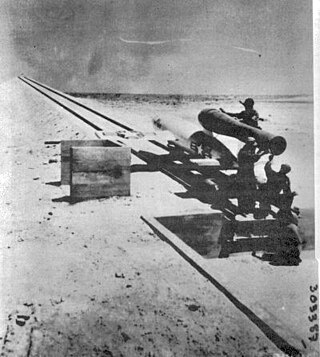
The 1st Experimental Guided Missiles Group is an inactive United States Air Force unit. It was last assigned to the Air Proving Ground Command and stationed at Eglin Air Force Base, Florida. It was inactivated on 22 July 1949.
Television guidance (TGM) is a type of missile guidance system using a television camera in the missile or glide bomb that sends its signal back to the launch platform. There, a weapons officer or bomb aimer watches the image on a television screen and sends corrections to the missile, typically over a radio control link. Television guidance is not a seeker because it is not automated, although semi-automated systems with autopilots to smooth out the motion are known. They should not be confused with contrast seekers, which also use a television camera but are true automated seeker systems.
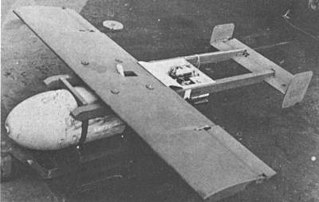
The GB-1, also known as the "Grapefruit bomb" and as XM-108, was a glide bomb produced by Aeronca Aircraft for the United States Army Air Forces during World War II. Intended to allow bombers to release bombs from outside the range of enemy defenses, over one thousand GB-1s were used in combat before the end of the war.
